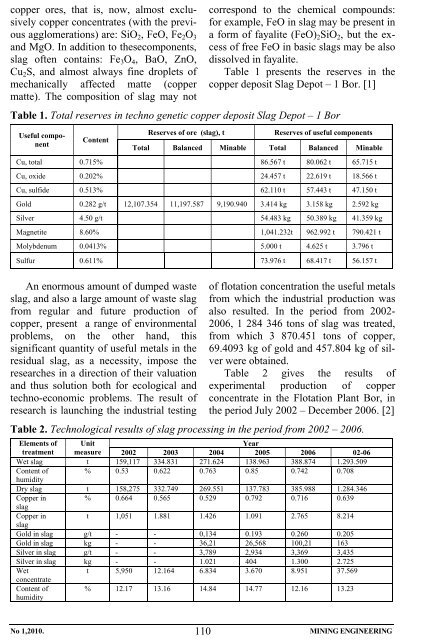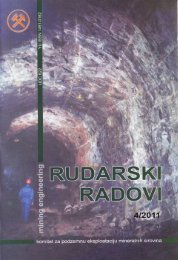Institut za rudarstvo i metalurgiju Bor
Institut za rudarstvo i metalurgiju Bor
Institut za rudarstvo i metalurgiju Bor
Create successful ePaper yourself
Turn your PDF publications into a flip-book with our unique Google optimized e-Paper software.
copper ores, that is, now, almost exclusively<br />
copper concentrates (with the previous<br />
agglomerations) are: SiO2, FeO, Fe2O3<br />
and MgO. In addition to thesecomponents,<br />
slag often contains: Fe3O4, BaO, ZnO,<br />
Cu2S, and almost always fine droplets of<br />
mechanically affected matte (copper<br />
matte). The composition of slag may not<br />
correspond to the chemical compounds:<br />
for example, FeO in slag may be present in<br />
a form of fayalite (FeO)2SiO2, but the excess<br />
of free FeO in basic slags may be also<br />
dissolved in fayalite.<br />
Table 1 presents the reserves in the<br />
copper deposit Slag Depot – 1 <strong>Bor</strong>. [1]<br />
Table 1. Total reserves in techno genetic copper deposit Slag Depot – 1 <strong>Bor</strong><br />
Useful component<br />
Content<br />
Reserves of ore (slag), t Reserves of useful components<br />
Total Balanced Minable Total Balanced Minable<br />
Cu, total 0.715% 86.567 t 80.062 t 65.715 t<br />
Cu, oxide 0.202% 24.457 t 22.619 t 18.566 t<br />
Cu, sulfide 0.513% 62.110 t 57.443 t 47.150 t<br />
Gold 0.282 g/t 12,107.354 11,197.587 9,190.940 3.414 kg 3.158 kg 2.592 kg<br />
Silver 4.50 g/t 54.483 kg 50.389 kg 41.359 kg<br />
Magnetite 8.60% 1,041.232t 962.992 t 790.421 t<br />
Molybdenum 0.0413% 5.000 t 4.625 t 3.796 t<br />
Sulfur 0.611% 73.976 t 68.417 t 56.157 t<br />
An enormous amount of dumped waste<br />
slag, and also a large amount of waste slag<br />
from regular and future production of<br />
copper, present a range of environmental<br />
problems, on the other hand, this<br />
significant quantity of useful metals in the<br />
residual slag, as a necessity, impose the<br />
researches in a direction of their valuation<br />
and thus solution both for ecological and<br />
techno-economic problems. The result of<br />
research is launching the industrial testing<br />
of flotation concentration the useful metals<br />
from which the industrial production was<br />
also resulted. In the period from 2002-<br />
2006, 1 284 346 tons of slag was treated,<br />
from which 3 870.451 tons of copper,<br />
69.4093 kg of gold and 457.804 kg of silver<br />
were obtained.<br />
Table 2 gives the results of<br />
experimental production of copper<br />
concentrate in the Flotation Plant <strong>Bor</strong>, in<br />
the period July 2002 – December 2006. [2]<br />
Table 2. Technological results of slag processing in the period from 2002 – 2006.<br />
Elements of Unit<br />
Year<br />
treatment measure 2002 2003 2004 2005 2006 02-06<br />
Wet slag t 159,117 334.831 271.624 138.963 388.874 1.293.509<br />
Content of<br />
humidity<br />
% 0.53 0.622 0.763 0.85 0.742 0.708<br />
Dry slag t 158,275 332.749 269.551 137.783 385.988 1.284.346<br />
Copper in<br />
slag<br />
% 0.664 0.565 0.529 0.792 0.716 0.639<br />
Copper in<br />
slag<br />
t 1,051 1.881 1.426 1.091 2.765 8.214<br />
Gold in slag g/t - - 0,134 0.193 0.260 0.205<br />
Gold in slag kg - - 36,21 26,568 100,21 163<br />
Silver in slag g/t - - 3,789 2,934 3,369 3,435<br />
Silver in slag kg - - 1.021 404 1.300 2.725<br />
Wet<br />
concentrate<br />
t 5,950 12.164 6.834 3.670 8.951 37.569<br />
Content of<br />
humidity<br />
% 12.17 13.16 14.84 14.77 12.16 13.23<br />
No 1,2010. 110<br />
MINING ENGINEERING



